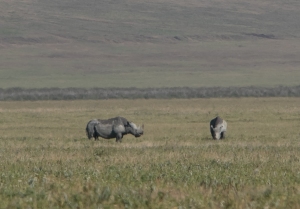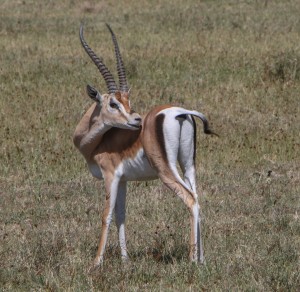Hope you’ve enjoyed learning about the culture of Africa; I certainly have, and it’s fun to document it through photography. However, the reason we came here was for the wildlife, so that’s what you’ll be reading and seeing through photographs from here on out.
In Africa, the rhino, lion, leopard, cape buffalo, and elephant are known as “The Big Five” because they are the hardest to kill. It becomes a goal of tourists to try to see all of them. We were no different, so we set out to find them (and more!). The two most difficult to see are the black rhino, which is solitary and few in number, and the leopard, which are also few in number and very shy. The Cape Buffalo is the most dangerous, and the lion is the only one that can kill all the others. Today we saw four of the five, and We are hopeful that we will see the leopard as well.
Our first game drive on day 1 of safari was through Taranguire National park, renowned for its elephant population. and we certainly found that out. By the second day, at one point, when an elephant herd came near the car, we were more interested in trying to photograph a bird in flight on the other side of the car! However, one of our initial encounters involved a herd passing very close to the car; so close that I could have reached out and touched the elephant’s eye. It was exhilarating to be so close, and to hear them breathe, grunt, fart, etc. They ignore vehicles as long as you are quiet, though one mother trumpeted angrily at us as we drove away after photographing her with her baby.

The elephants are wonderful to watch in the water; they roll, wallow, spray themselves and each other, and just have a big old time playing and cooling off from the heat. Then they get out, and blow huge clouds of dust on themselves with their trunks.

The giraffes are tall and gangly, yet graceful. They eat the leaves of the Acacia tree, which is the common tree in Africa, even though it has 2 inch thorns on it.

Along with the elephants, we saw herds of giraffe, jackals, ostrich, wart hogs (which George calls “lion chocolate”), gazelles,. impalas, and many beautiful birds, which are probably my favorite creatures to photograph no matter where I am. You probably know as much about them as we do, so just enjoy the photos. Taranguire was really about the elephants and giraffe.
And of course, no African safari would be complete without the mention of the dreaded tse tse fly. Pre-trip research indicated that they were almost everywhere, they bite unmercifully, and no insect repellant was effective. They are attracted to the colors blue and black, so we did not wear those colors. Sure enough, the little bastards were constantly with us, and even got in a couple of bites on my hand, but all in all, they weren’t as bad as we had feared, ‘and we had dressed appropriately, wearing lightweight long sleeve shirts and pants.
After Taranguire, we headed to the mountainous area, which is lush and cool. As we got into the highlands, we saw cape buffalo and baboons.

Ngorogoro crater is there, and has one of the most diverse, yet beautifully interconnected ecosystems imaginable in one contained space. Our lodge was situated right on the rim of the crater, affording us a stunning sunrise and sunrise over the crater.

We were up early, anticipating the sighting of the black rhino and maybe the big cats, which become less active in the heat of the afternoon. Upon arriving at the bottom of the crater, we immediately spotted hippos cooling off in the water, though they refused to do anything other than snort bubbles once in awhile. All around us everywhere in the crater were zebras, wildebeest, gazelles, and herds of Cape Buffalo, all peacefully coexisting.

Many had babies, and occasionally ran or turned to look at us if we got close. George is incredible at spotting wildlife, and soon pointed out two rhino far away. Fortunately, we were able to capture them with our long lenses, and felt lucky to have even seen them.

Even from a distance they look large and menacing. We spotted several male lions napping quite near the side of the road. Eventually one rolled over, presenting us briefly with his face, but overall they were quite unconcerned and not active. Just being that close to them was exciting. We observed jackals and hyenas skulking or running around the animals, checking out herds for the weak, the sick or babies.

It was so fascinating to see all this occurring within one area, seeing so many parts of an ecosystem functioning right before our eyes. It was very cool.
As we exited the crater, the views were breathtaking.

We were very pleased to spotted four of the big five so far (Cape Buffalo, lion, elephant, and rhino). We are now on our way to the Serengeti, where George assures us that our chances are fairly good for seeing the leopard.
Most of the photography up to this point has been of slow-moving or stationary animals, and what excites me most about photography is capturing action and motion; capturing what is happening rather than just what things look like. George says we should see much more of that in the Serengeti, where there are many more animals, and they are migrating, so I’m hopeful. We are taking a balloon ride over the Serengeti early tomorrow morning, and I am terrified at the thought ( I really HATE heights) but very excited at the same time. The thought of looking down and seeing the Serengeti in all its splendor is exhilarating. I should have brought some Depends, as I do worry a bit about pissing myself when we go up. But we only live once, and I can clean myself up if needed. Hopefully, it will be worth it.
Thanks for following the continuing adventure!



Thank you, thank you, thank you! I’m LOVING your adventure!!
Sent from my iPhone
>
LikeLiked by 1 person
I can’t believe you are taking a balloon ride! I shake at the thought of it! Hope you don’t need those Depends!
LikeLiked by 1 person
Shawna, I had absolutely NO problem a all with it! It was just peaceful, and I always felt safe. The height did not bother me at all.
LikeLike
So exciting! Thanks for sharing this. I am so with you on the balloon ride. You gott go up, but it might be a double diaper experience 🙂
LikeLike
This is amazing Kathy! To enjoy this splendor with seeing how the animals are in their own natural habitat is an incredible experience! I love all the photos you are taking! You are getting to see quite a bit! As for the hot air balloon ride, I think you will be so taken aback by the scenery and such, you will not be phased by the height issue. You got this!
Pam
LikeLike
I am reliving my African safari trip thru your abolutely amazing pictures. I didn’t have all that great camera equipment so enjoying yours! I know the feeling when you see your first giraffe with eyelashes that seem a foot long or when your safari vehicle chases a cheetah! It is truly a trip your will always remember.
LikeLike